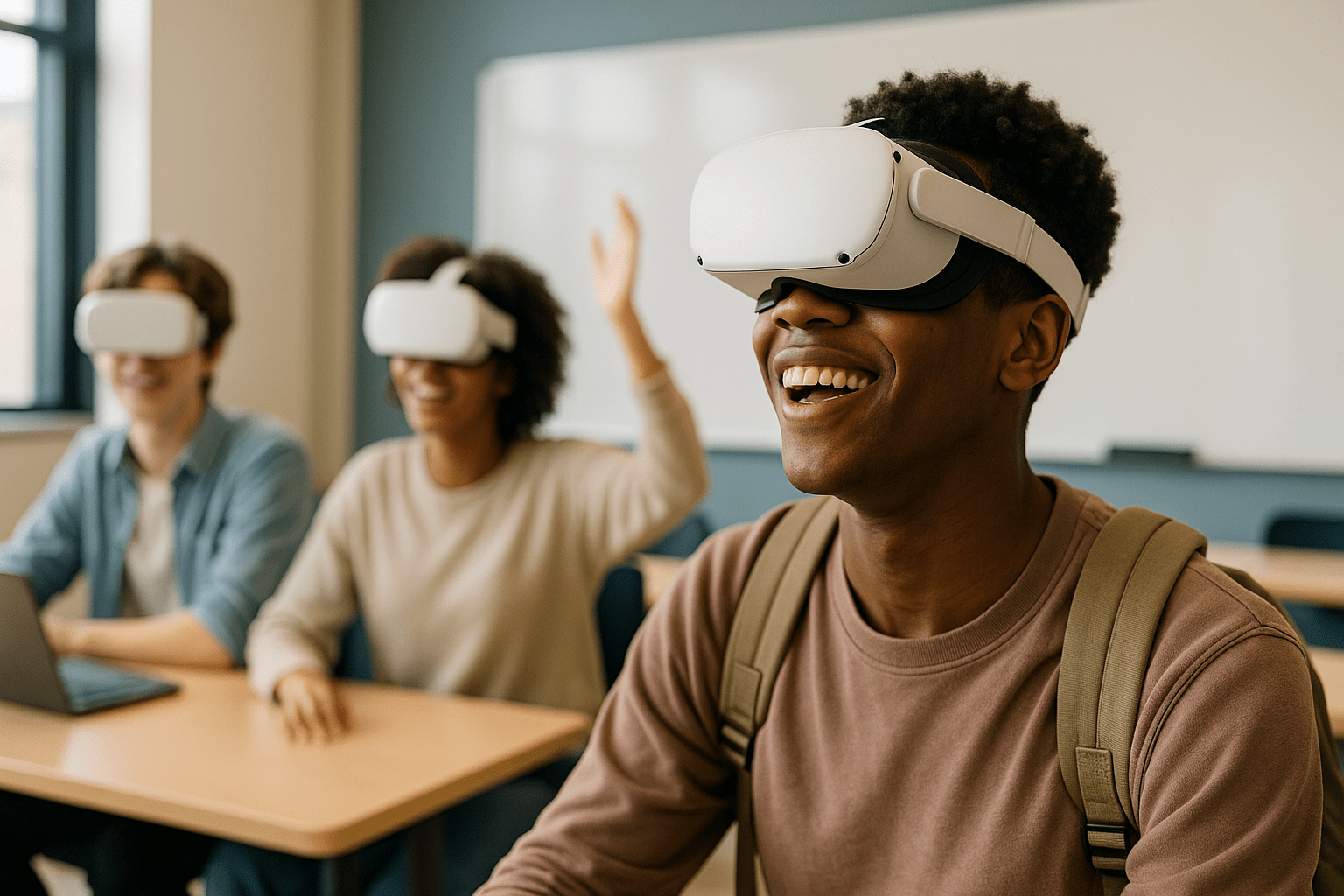AR and VR in Education Explained with Real Classrooms in Mind
If you’ve ever watched a student light up during a hands-on activity, you already understand the power of immersive learning. That’s what makes Augmented Reality (AR) and Virtual Reality (VR) so compelling for education. These technologies are no longer just flashy add-ons-they’re changing how learners engage, collaborate, and understand difficult concepts. But AR and VR aren’t the same thing, and the differences matter when deciding how to use them in your school, university, or training organisation. Augmented Reality enhances the real-world experience by overlaying digital information, while Virtual Reality immerses learners in a completely simulated environment. Understanding these distinctions is crucial for leveraging their unique benefits effectively. As educators explore the potential of virtual reality in education, they can create unforgettable experiences that deepen student engagement and facilitate better comprehension of complex subjects.
In this post, we’ll walk through the ways AR and VR support different kinds of learning, how they’ve been successfully integrated with e-learning platforms like Moodle™ software, and what to keep in mind when introducing them into your own learning environment.
Augmented Reality vs Virtual Reality What’s the Difference?
This is where most educators get stuck-AR and VR sound similar but work very differently.
- Augmented Reality (AR) adds digital information to real-world environments. Think historical facts appearing over live images of museum exhibits, or interactive 3D models hovering over a textbook through a tablet screen.
- Virtual Reality (VR) replaces the physical world entirely. Students wear headsets and get transported into fully simulated environments-like a 3D-rendered heart they can virtually walk inside, or a recreated World War I trench they can explore.
Both serve different educational goals. AR is great for contextual overlays without removing learners from their surroundings. VR shines when total immersion is needed.
Common Educational Uses of AR and VR with Moodle™ Software
Here’s where things get practical. Integrating AR and VR into learning with Moodle™ software enables more engaging experiences in areas like: Students can explore complex concepts in a more interactive manner, enhancing their understanding and retention. By leveraging these technologies alongside Moodle™, educators can create smarter classrooms with AI integration, allowing for personalized learning paths that adapt to individual student needs. This fusion of immersive environments and AI-driven insights ensures that learners are not only engaged but also challenged to think critically and creatively.
- Science & Anatomy: Students study internal organs in 3D using VR, enhancing comprehension without needing a physical lab.
- Geography: AR overlays can show live weather systems on maps viewed through tablets, tied directly to course activities.
- Language Arts: Immersive story worlds can help learners understand narrative structure or explore historical language use.
- Technical Training: VR simulations allow practice with machinery or tools in safe, recreated environments.
- Exams and Skill Assessment: Learners can interact with virtual tools that adjust based on Moodle™ activity-based learning paths.
Benefits of AR and VR in Learning Environments
If you’re wondering whether it’s worth the investment, here are some of the most consistently reported improvements:
- Higher engagement: Learners are more likely to stay involved-especially those who struggle with passive lectures.
- Better spatial understanding: Perfect for fields like architecture, aeronautics, or medicine.
- Safe rehearsal environments: Like learning to fly a plane (virtually!) before even touching a cockpit.
- Accessible experiences: Virtual field trips let students ‘visit’ places without needing permission slips and packed lunches.
And yes, it can be fun. One teacher admitted, “The students were so into the VR activity they didn’t notice the bell ring… for lunch. That’s how I knew something special was happening.”
Challenges and Considerations for Implementation
Here’s the tricky part. As exciting as AR and VR sound, integrating them into established learning settings comes with some bumps:
- Cost of Equipment: VR headsets and AR-compatible devices can be expensive, especially at scale.
- Teacher Training: Many educators need support on how to design meaningful activities, not just flashy ones.
- Curriculum Alignment: It’s easy to use AR/VR for the “wow” factor-but harder to make it tie back to assessment outcomes.
- Device Compatibility: Not all devices work smoothly with AR/VR content or Moodle™ plugins. Piloting small programs first often helps.
Planning for Success with AR and VR in e-Learning
Start simple. Don’t try to transform your entire curriculum overnight. Here’s a sequence that’s worked for many of our clients:
- Pick one topic where visual/spatial understanding really matters.
- Set clear learning outcomes and link them to Moodle™ software activities or quizzes.
- Use existing VR experiences (many libraries have free ones) or build lightweight AR content with simple tools like Metaverse Studio.
- Test it with a small group, gather student feedback, and iterate from there.
Tip: Moodle™ community forums are goldmines of teacher-shared AR/VR lesson plans. Don’t reinvent the spaceship when someone’s already built the rocket.
Collaborative Learning Through Virtual Environments
Students don’t need to explore Venus alone. VR and AR support group collaboration in ways regular content can’t:
- Shared missions or problem-solving tasks in a VR space offer real-time group learning.
- AR scavenger hunts, where students complete challenges visible only through their devices, promote movement and teamwork.
- Integrated messaging and forums in Moodle™ software tie activities directly to classroom discussion and reflection.
Is One Better Than the Other?
This is like asking, “Is a microscope better than a telescope?” Both show you something invaluable-you just use them for different jobs.
If your goal is enhancing live learning environments with extra information-start with AR. If you want transportive, full-session immersion-VR is your pick. Many institutions find combining them, based on subject and age group, gets the best results.
Where Moodle™ Software Fits Into the AR and VR Picture
Moodle™ software offers built-in SCORM support and plugins that can host 3D content, simulations, and link out to third-party AR/VR platforms. With the right configuration, you can:
- Track completion of VR activities as course progress
- Attach AR content to Moodle™ activities and quizzes
- Use forums or assignments to support collaborative post-VR reflection
You might not expect this, but some of the most successful AR/VR projects started not with a tech team, but with one passionate teacher and a coffee-fueled late night.
FAQs About AR vs VR in Education
What’s the main difference between AR and VR in educational settings?
AR overlays digital content onto the real world-great for enhancing what’s physically in front of students. VR replaces the entire environment, offering full immersion in a simulated space. Both can be used in education, but their applications differ depending on the learning goal.
Are AR and VR suitable for all age groups?
Generally yes, but with some considerations. AR tends to be more accessible for younger learners since it doesn’t require wearing headsets. VR, while highly immersive, is better suited for secondary, tertiary, or adult learners due to safety and content alignment.
Can AR/VR content be added to Moodle™ software courses?
Yes. Moodle™ software supports embedded media, SCORM packages, and plugins that can host or link to AR/VR experiences. Many educators use external platforms to create content and integrate them via activity modules, labels, or web links inside courses. These integrations enhance the learning experience by providing diverse and interactive content that caters to various learning styles. By leveraging these technologies, educators can create a more engaging environment for students, making courses more accessible to all learners. Additionally, the ability to incorporate multimedia elements fosters collaboration and communication among students, enriching the overall educational journey.
What equipment is needed for VR or AR in classrooms?
For AR: tablets or smartphones with cameras; for VR: devices like Meta Quest, HTC Vive, or Google Cardboard. Software tools and AR/VR platforms vary, so compatibility checks are key before rolling anything out.
Are there affordable ways to get started?
Yes. Many AR creation tools are free or low-cost. For VR, libraries of simulations are available online for educational use. Starting with shared devices or trials in specific topics makes it manageable without large investment upfront.
Final Thoughts and Next Steps
AR and VR aren’t just buzzwords or disposable fads. Used thoughtfully-especially when integrated with platforms like Moodle™ software-they can genuinely enhance teaching, boost learner retention, and make education more accessible, emotional, and even joyful.
Thinking about how to bring AR and VR into your learning environment? At Pukunui Sdn Bhd, we help institutions across Malaysia and beyond plan, implement, and extend their Moodle™ software ecosystems-including AR/VR-friendly workflows and training support.
Let’s talk about what would work for your learners. Get in touch with our team for practical help and a clear strategy that suits your budget and goals.

